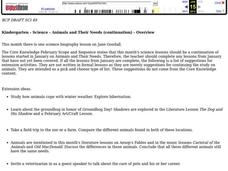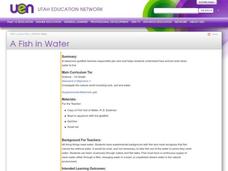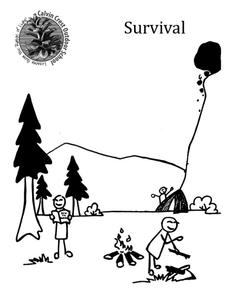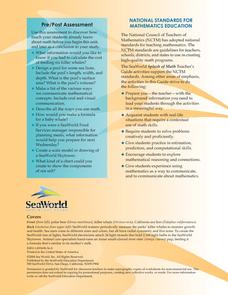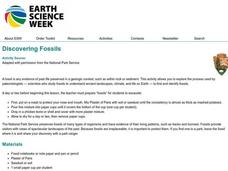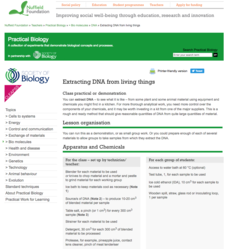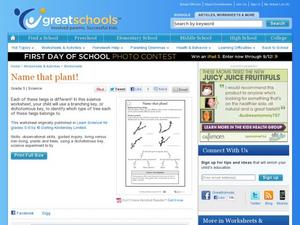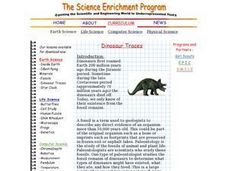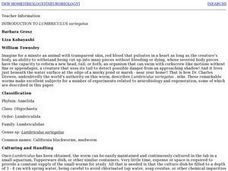Curated OER
Jane Goodall
Students identify Jane Goodall as a scientist who studies the behavior of chimpanzees. They listen to a biography of Jane Goodall and review the location of Africa. Then students participate in an animal observation activity.
Curated OER
A Fish in Water
First graders, with a goldfish as a class pet, practice the proper way to care for a pet and have responsibilities when it comes to taking care of the fish. As a class, the teacher reads the book "Fish Out of Water".
Curated OER
The Symbolic Importance of Animals
Students create individual examples of the Chinese Zodiac using pizza boards, pictures of zodiac animals, and art supplies. Evaluation of student progress is done through full-class and small group discussions.
Curated OER
Horses
Students discuss the importance of the horse as a "beast of burden" animal in Japanese culture and create a legend, myth or tall tale set in Japan with a horse as the central character.
Curated OER
Get Cracking
Young scholars compare the life cycle of an animal hatched from an egg with one born from its mother's womb. The lesson focuses on dinosaur eggs. They create dinosaur eggs from balloons and papier mache.
Nuffield Foundation
Observing Earthworm Locomotion
One acre of land can contain more than a million earthworms. Scholars collect earthworms to observe their movements. Once placed on paper, the sound of movement often fascinates pupils. When placed on glass, the earthworm is unable to...
Curated OER
Kids Can Help
For this helping worksheet, students read about ways they can help pets affected by Hurricane Katrina. These include raising money to support the HSUS Disaster Relief Fund, by holding a car wash, bake sale, or auction.
Calvin Crest Outdoor School
Survival
Equip young campers with important survival knowledge with a set of engaging lessons. Teammates work together to complete three outdoor activities, which include building a shelter, starting a campfire, and finding directions in the...
Curated OER
Pollination Power
Second graders study and examine the structure of a flower. In this pollination lesson, 2nd graders observe pollinators in the garden and dissect a flower. Students then plant strawberry plants in the garden and observe the process...
Sea World
Splash of Math
How can kids use math to learn about marine life? Combine math skills with science lessons in a resource featuring activities about life in the sea. Kids graph and calculate data, solve complex word problems, measure geometric shapes,...
Outdoor Learning Center
Outdoor Survival
Which of the following can you survive without for the longest time: water, food, or a positive mental attitude? The answer may surprise you. Guide learners of all ages through games, activities, and discussions about surviving in the...
Curated OER
Be Kind to Your Teeth
What kinds of food can be bad for your teeth? Kindergartners and first graders explore dental health with an interactive science inquiry. Given a choice of foods such as celery, cake, and milk, kids choose which ones are better for their...
Curated OER
Discovering Fossils
Students explore fossils. In this fossils geology lesson, students use tools to reveal embedded "fossils" (made with plaster of Paris by the teacher-instructions included), then describe and illustrate their findings.
American Chemical Society
What is a Chemical Reaction?
When a candle burns down, what happens to the mass that appears to be shrinking? Lesson begins with a demonstration of the chemical reaction of a candle burning. Then scholars use atom models to observe conservation of mass...
Nuffield Foundation
Extracting DNA from Living Things
Help! Someone's trying to take my DNA! An interesting lab experiment has scholars use basic materials to extract DNA. By applying ethanol, cold water, and a protease enzyme, like pineapple juice, they pull strands of DNA from peas,...
Curated OER
Discovering Owls
Students are introduced to different types of owls and owl pellets. They list several adaptations that benefit the owls. Students identify the various species of owl that live in Wisconsin. Students discuss owl pellets and identify the...
Curated OER
How to Make a Paper Snowflake
In this winter activity worksheet, students follow the 9 steps provided to make paper snowflakes. The finished art project may used for various classroom activities.
Curated OER
What is an Insect?
Students examine insects and identify physical characteristics of insects. They perform observations of insects, then use a worksheet imbedded in this plan to answer questions about them.
Curated OER
Name that plant!
What is a dichotomous key? When your kids ask, hand them a learning exercise like this one, to explain it. They use the key to identify four different trees, based on the budding twigs they've produced. Tip: Have learners extend this...
Curated OER
March Answer Key
In this Easter worksheet, students read a letter to their parents. The 10 words in italics can also be removed in order to create a fill-in-the blank exercise.
Curated OER
Portrait Sculptures
Third graders identify characteristics that they have in common with animals. They create a self-portrait sculpture combining the body structures of different animals. They create the sculpture armature, plaster the armature, and then...
Curated OER
Beach Life: Clam Dissection
Students investigate clams. In this clam life instructional activity, students conduct an experiment where they dissect clams. Students compare anatomies of humans and clams.
Curated OER
Dinosaur Traces
Learners identify and interpret the type of evidence found at a typical dinosaur dig and mimic a paleontologist by taking crayon rubbings of simulated bone impressions. After the rubbings are taken, the students reconstruct the complete...
Curated OER
Introduction to Lumbriculus variegatus
Students conduct two set experiments on Lumbriculus worms and create a third experiment of their own. The first of the two set experiments allows students to observe regeneration of the worms while the second allows students to test the...


